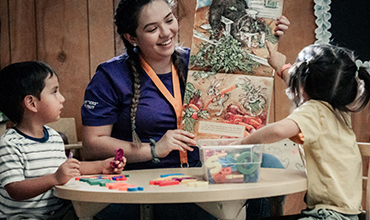As parents, we sometimes over-complicate things when it comes to activities with our kids, especially for infants and toddlers. In the name of “learning” and “education,” we often forget that some of the most basic things can be the most instructive…and the most fun. Turns out experts have come up with a name for it: play-based learning. With a little creativity you can turn everyday tasks and playtime into opportunities for learning and development.
Engage Your Senses: One way to make the most of your time together is to incorporate a variety of sensory experiences into your activities. For example, you can create a “sensory bin” filled with items like rice, beans, or pasta, and let your child explore the textures and sounds with their hands and feet.
See It, Say It: Another way to make playtime more educational is to incorporate language and literacy activities. You can read books together, sing songs, and play with word and letter blocks. These activities can help to develop your child’s listening and speaking skills, as well as their vocabulary.
Get Crafty: Art and craft activities build new neuropathways in your child’s brain. Finger painting, for example, can be a great way to help develop their fine motor skills, while also encouraging creativity and self-expression. You can also create simple crafts using items you have around the house, such as cardboard boxes or paper towel rolls, which can help to develop your child’s problem-solving and spatial awareness skills. As many of us have recently learned during the holidays, your child’s favorite new toy might just be the giant box their gift came in.
Get Physical: Physical activity produces a variety of mental and emotional benefits in addition to the obvious physical ones. For example, you can take your child for a walk, have a dance party, or play “Follow the Leader.” These activities can help to improve your child’s gross motor skills, balance, and coordination. One easy favorite is batting a balloon with a ping pong paddle, developing both agility and eye-hand coordination.
Get Down to Their Level: Finally, it is important to get on the floor and play with your child. Seeing you on their level, eye-to-eye, enables your child to make a stronger emotional attachment. Rolling around on the floor or grass with your child can provide some of your best parenting memories.
By incorporating a variety of sensory experiences, language and literacy activities, art and craft activities, physical activity and playtime, you can help your child to develop a wide range of skills and have fun together at the same time.
Contributed by YMCA of Austin.














